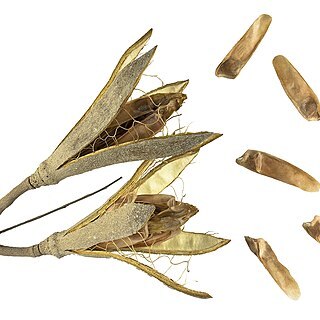A tree. It grows 9-18 m high. The trunk is 2 m around. The crown is rounded. The bark is thick, silvery grey and cracked. The leaves are compound with leaflets along the stalk. The leaflets are opposite of alternate and there may or may not be a leaflet at the end. The leaflets are 11 cm long by 5 cm wide. They have a wavy edge. The flowers are white and have a scent. They are in groups 30 cm long in the axils of leaves. The fruit are erect and woody capsules. These are 10-12 cm long and have brown seeds.
A savannah tree, commonly 20–30 ft high, sometimes up to 60 it high and 6 ft girth
Panicles of fragrant white flowers
Foliage grey silvery when young
Bark grey, fissured
Fruits erect


